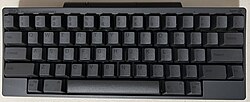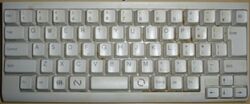Engineering:Happy Hacking Keyboard
Template:Infobox keyboard The Happy Hacking Keyboard (HHKB) is a small computer keyboard produced by PFU Limited of Japan, codeveloped with Japanese computer scientist and pioneer Eiiti Wada.[1] Its reduction of keys from the common 104-key layout down to 60 keys in the professional series is the basis for it having smaller overall proportions, yet full-sized keys. It returns the control key to its original position as on the early 84-key IBM Personal Computer/AT and XT layouts. The current models[2] in production are the Happy Hacking Keyboard Professional Classic,[3] Professional Hybrid (wired/wireless dual connectivity),[4] and Professional Hybrid Type-S[5] (silenced variant of Hybrid) all in either dark or light colorschemes, and either blank or printed keycaps. Professional Hybrid models are also available in Japanese layout.
History
Beginnings
Frustrated that each new computer system came with a new keyboard layout that became increasingly complex, Wada sought to create his own keyboard that he could continue to use with various different computer systems. Inspired by the original Macintosh keyboard,[6] Professor Wada and PFU collaborated to design the Happy Hacking Keyboard with the following philosophy:
Because keyboards are accessories to PC makers, they focus on minimizing the manufacturing costs. But that’s incorrect. When America’s cowboys were in the middle of a trip and their horse died, they would leave the horse there. But even if they were in the middle of a desert, they would take their saddle with them. The horse was a consumable good, but the saddle was an interface that their bodies had gotten used to. In the same vein, PCs are consumable goods, while keyboards are important interfaces.
During the design process, Wada had mock-ups of the keyboard both with printed and blank keycaps; he found that his students quite liked blank keycaps and the tradition of HHKB's with blank keycaps continues to this day.
The first Happy Hacking keyboard (HHKB) was released in 1996 and used membrane keyswitches. It used PS/2, Sun, and ADB interfaces to connect to a computer with a detachable cable and is only available in white. The first HHKB was followed by the release of the HHKB Lite and HHKB Lite2 in 1999 and 2001 respectively. The HHKB Lite models also used membrane keyswitches but have a slightly different layout than the standard HHKB. The HHKB Lite is the first HHKB model to be available in black and the HHKB Lite2 is the first HHKB model to use the USB interface.
HHKB Professional Series
First-generation
The first HHKB Professional (not to be confused with the previously mentioned first HHKB) was released in December 2003 and is available in either white or charcoal (black) colorways with either blank or printed keycaps. Retroactively known as the HHKB Professional 1, this is the first HHKB model to use the famous Topre electrostatic capacitive keyswitches that all subsequent models use to this day. It also features a detachable mini-USB cable which is used to connect the keyboard to a computer.
Second-generation
The HHKB Professional 2 was released in March 2006 and is also available in either white or charcoal (black) with either blank or printed keycaps. Its main feature is a built-in 2-port USB hub for connecting mice and other peripherals.
In 2011, PFU released the HHKB Professional 2 Type-S. Only available in white (but with either blank or printed keycaps), the HHKB Professional 2 Type-S is a silenced variant of the HHKB Professional 2 containing silenced Topre keyswitches.
Another variant of the HHKB Professional 2 called the HHKB Professional BT, was released in 2016. This is the first HHKB to feature Bluetooth connectivity. HHKB Professional BT models run on AA batteries housed in a "battery bump" on the rear of the keyboard and can only be connected using Bluetooth (although these models have a micro-USB port, it can only be used to power the keyboard in place of batteries and not for data transmission).
Third-generation

The third-generation models of HHKB Professional: Classic, Hybrid, and Hybrid Type-S – were released in December 2019.[7] These third-generation models feature 100% PBT keycaps, where previous models used ABS for the space bar. Furthermore, the third-generation models feature USB-C connectivity instead of mini-USB. HHKB Professional Hybrid models run on AA batteries housed in a "battery bump", similar to the previous HHKB Professional BT. However, unlike the HHKB Professional BT, these models can also be used with a wired connection via the USB-C port. HHKB Professional Hybrid models also support PFU's official key remapping software.

Common features
Some of the Happy Hacking Keyboard design tenets, as dictated by Wada, include a minimal 60-key design, no cursor or function keys, and standard keyboard pitch, all optimized for use in Unix environments.[8]
Happy Hacking Keyboards lack a numeric keypad, and keys outside the typewriter key area are mainly accessible through the Fn key. The keys are arranged in a layout resembling the Sun Type 3 keyboard. Specifically:
- The control key is placed where most keyboards place the caps lock. This is the only control key on the keyboard.
- The esc key is located to the left of the 1 key; the tilde key normally found there is at the right end of the same row.
- The delete key is located directly above the enter key; the key normally found there is the second-rightmost key on the row above it. Further, this is a true delete key, not a historically named backspace. Backspace is accessible via though its function can be interchanged with the backspace key using a DIP switch, using this setting, the delete key is accessed via
- The meta keys are located between the space bar and the alt keys.
On the far side of the keyboard there are DIP switches. These may be used to:[9]
- Turn the delete key into a backspace. remains backspace, and (top-right key) remains delete.
- Swap the alt and meta keys.
- Enable/disable downstream USB ports on USB models.
- Set the OS
- Enable/disable power-saving mode on HHKB Hybrid models
Its size is roughly half the size of A4 paper.
Model overview
Model names with JP denote a Japanese layout variant.
| Model name | Model # | Color | Switch type | Interface | Blank keycaps | Introduced | EOL | Notes |
|---|---|---|---|---|---|---|---|---|
| Happy Hacking Keyboard | PD-KB02 | White | Membrane | PS/2, Sun, ADB | No | Dec 20, 1996 | Dec 10, 2006[10] | Buzzer (Sun), Power supply switch (Sun/Mac) |
| PD-KB02N | ||||||||
| Happy Hacking Keyboard Lite | PD-KB100W | White | PS/2 | Jun 7, 1999[11] | Unknown | Was also available in black and white unlabeled versions[12] | ||
| Happy Hacking Keyboard Lite 2 | PD-KB200W/P | White | Mar 15, 2001[13] | Dec 19, 2008 | Arrow keys, 2-port USB hub. Available in Japanese and English layouts. | |||
| PD-KB200B/P | Black | |||||||
| PD-KB200W/U | White | USB | ||||||
| PD-KB200B/U | Black | |||||||
| PD-KB210W/U | White | |||||||
| PD-KB210B/U | Black | |||||||
| PD-KB220W/U | White | |||||||
| PD-KB220B/U | Black | |||||||
| PD-KB220MKW | White | Mac version, has command and option keys in addition to the other Lite 2 features.[14] | ||||||
| PD-KB200MKB | Black | |||||||
| PD-KB200MA | White | |||||||
| PD-KB220MA | White | |||||||
| Happy Hacking Keyboard Professional | PD-KB300 | White | Topre capacitive[15] | Apr 24, 2003 | Dec 10, 2006[10] | First HHKB to use Topre keyswitches | ||
| PD-KB300B | Charcoal | |||||||
| PD-KB300NL | White | Yes | ||||||
| PD-KB300BN | Charcoal | |||||||
| Happy Hacking Keyboard Professional 2 | PD-KB400W | White | No | Mar 24, 2006[16] | Dec 10, 2019 | |||
| PD-KB400B | Charcoal | |||||||
| PD-KB400WN | White | Yes | ||||||
| PD-KB400BN | Charcoal | |||||||
| Happy Hacking Keyboard Professional 2 JP | PD-KB420W | White | No | Nov 10, 2008 | ||||
| PD-KB420B | Charcoal | |||||||
| Happy Hacking Keyboard Professional HG[17] | PD-KB500W | White | No | Oct 12, 2006 | Special 10-year anniversary models[18] | |||
| PD-KB500B | Black | |||||||
| PD-KB500WN | White | Yes | ||||||
| PD-KB500BN | Black | |||||||
| Happy Hacking Keyboard Professional HG JAPAN[19] | PD-KB500J | Wajima-style lacquer | ||||||
| Happy Hacking Keyboard Professional 2 Type-S | PD-KB400WS | White | No | Jun 29, 2011 | Silenced variant[20] | |||
| PD-KB400WNS | Yes | |||||||
| Happy Hacking Keyboard Professional 2 Type-S JP | PD-KB420WS | No | ||||||
| Happy Hacking Keyboard Professional BT[21] | PD-KB600B | Charcoal | Bluetooth | No | Apr 12, 2016 | First HHKB to use Bluetooth | ||
| PD-KB600BN | Yes | |||||||
| PD-KB600W | White | No | ||||||
| PD-KB600WN | Yes | |||||||
| Happy Hacking Keyboard Professional BT JP | PD-KB620B | Charcoal | No | |||||
| PD-KB620W | White | |||||||
| Happy Hacking Keyboard Professional Classic | PD-KB401W | White | USB-C | No | Dec 10, 2019 | |||
| PD-KB401WN | Yes | |||||||
| PD-KB401B | Charcoal | No | ||||||
| PD-KB401BN | Yes | |||||||
| Happy Hacking Keyboard Professional Hybrid | PD-KB800W | White | Dual mode USB-C or Bluetooth | No | ||||
| PD-KB800WN | Yes | |||||||
| PD-KB800B | Charcoal | No | ||||||
| PD-KB800BN | Yes | |||||||
| Happy Hacking Keyboard Professional Hybrid JP | PD-KB820W | White | No | |||||
| PD-KB820B | Charcoal | No | ||||||
| Happy Hacking Keyboard Professional Hybrid Type-S | PD-KB800WS | White | No | Silenced variant | ||||
| PD-KB800WNS | Yes | |||||||
| PD-KB800BS | Charcoal | No | ||||||
| PD-KB800BNS | Yes | |||||||
| Happy Hacking Keyboard Professional Hybrid Type-S JP | PD-KB820BS | White | No | |||||
| PD-KB820WS | Charcoal | No |
See also
- List of mechanical keyboards
- Das Keyboard
- FrogPad
- Optimus Maximus keyboard
- Model M keyboard
- Space-cadet keyboard
References
- ↑ "IIJ Research Laboratory - Researchers". http://www.iijlab.net/researchers.html.en.
- ↑ "Happy Hacking Keyboard (manufacturer's site)". https://hhkeyboard.us/happyhacking/.
- ↑ "HHKB Professional Classic". https://hhkeyboard.us/happyhacking/pro-classic/.
- ↑ "HHKB Professional Hybrid". https://hhkeyboard.us/happyhacking/pro-hybrid/.
- ↑ "Happy Hacking Keyboards Pro HYBRID Type-S Keyboard - HHKP & REALFORCE Keyboards" (in en-US). https://hhkeyboard.us/happyhacking/pro-hybrid-type-s/.
- ↑ "Eiiti Wada Mechanical Keyboard Community Interview | Massdrop". 2018-09-26. https://www.massdrop.com/article/eiiti-wada-interview.
- ↑ "高性能コンパクトキーボード「Happy Hacking Keyboard」ラインナップ一新 | 株式会社PFU" (in ja). https://www.pfu.fujitsu.com/news/2019/new191210.html.
- ↑ "Wada Eiiti". Information Processing Society of Japan. http://museum.ipsj.or.jp/en/pioneer/e-wada.html.
- ↑ "DIP switch functions". http://www.pfusystems.com/hhkeyboard/leaflet/hhkb_backview.html.
- ↑ 10.0 10.1 "Happy Hacking Keyboard Specifications". http://www.pfusystems.com/hhkeyboard/spec.html.
- ↑ "PFU America releases "Happy Hacking Keyboard Lite" for all PC/Linux users and power users". 1999-06-01. http://www.pfuca.com/news/new_lite.html.
- ↑ "Happy Hacking Keyboard Lite". http://www.pfuca.com/products/hhkb/hhkblite.html.
- ↑ "PFU America Releases "Happy Hacking Keyboard Lite 2"". 2001-03-15. http://www.allbusiness.com/technology/software-services-applications-internet-social/6045674-1.html.
- ↑ Murph, Darren (2007-01-26). "Happy Hacking Keyboard Lite 2 for Mac touts Apple Key, demotes Caps Lock". Engadget. https://www.engadget.com/2007/01/26/happy-hacking-keyboard-lite-2-for-mac-touts-apple-key-demotes-c/.
- ↑ "HHKB/Features/High quality keys". http://www.pfusystems.com/hhkeyboard/leaflet/keyspec.html.
- ↑ "Happy Hacking Keyboard Professional 2". 2006-03-16. http://www.akibalive.com/archives/000686.html.
- ↑ "HHKB Professional HG Specs". http://www.pfu.fujitsu.com/hhkeyboard/hhkbprohg/spec.html.
- ↑ "The 3300 euros keyboard for PC". Akihabaranews. 2006-10-12. http://www.akihabaranews.com/en/news-12585-The+3300+euros+keyboard+for+PC.html.
- ↑ "HHKB Professional HG JAPAN Specs". http://www.pfu.fujitsu.com/hhkeyboard/hhkbprohg/j_spec.html.
- ↑ "HHKB Professional 2 and JP Type-S press release". http://www.pfu.fujitsu.com/news/2011/new110615.html.
- ↑ "Happy Hacking Keyboard: HHKB Professional BT: PFU". http://www.pfu.fujitsu.com/hhkeyboard/bt/.
External links
- HHKB firmware, tools and manuals
- Eiiti Wada Mechanical Keyboard Community Interview
- Verge celebrates the Happy Hacking Keyboard as a status symbol
- engadget review of the Happy Hacking Keyboard Lite 2
- Linux Journal review of the Happy Hacking Keyboard Professional
- Review & spec of the Happy Hacking Keyboard Pro 2
- Linux Journal review of the original Happy Hacking Keyboard
 |
